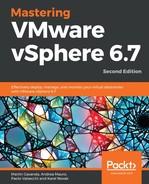With VMware, there are several options when talking about hyper-converged infrastructure, but they always include three major components—VMware vSphere, VMware vSAN, and VMware NSX.
- vSAN ReadyNode: vSAN ReadyNode is a standard x86 server, available from all the leading server vendors, that have been pre-configured, tested, and certified for VMware Hyper-Converged Infrastructure (HCI) software. Each ReadyNode is optimally configured for vSAN with the required amount of CPU, memory, network, I/O controllers, and storage (SSDs, HDDs, or flash devices).
- Integrated solutions: Some vendors can deliver a complete SDDC as a turnkey solution. Everything is preconfigured and tested, and all you need to do is plug in the cables. This way, not only is the hardware preconfigured, but the software is as well. You do not need to spend time with the configuration of NSX or vSAN. This approach can save a lot of time and cut down on administration, and so is ideal either in case of limited time or lack of advanced skills.
One example of such a product is Dell EMC VxRack. Based on your requirements, the whole solution is designed by Dell EMC technical specialists and contains everything including racks, physical network switches, servers, all software components, and centralized management.
- Building your own system: Building your own system is probably the most challenging approach, but gives you the greatest flexibility. You can decide how to combine and configure resources based on your specific requirements. Although you must still ensure hardware and software compatibility, you get to select the server, network, storage, and other components. This lets you put together a system that best suits your business needs. You can configure your server independently, such as by adding memory, swapping out disks, upgrading CPUs, all the while still scaling out by adding complete nodes.
This granular scalability is thanks to the ability to use commodity hardware, rather than being locked into the types of custom-engineered systems that many vendors sell. With commodity hardware, you can build a hyper-converged platform with less investment, replace and scale up components when necessary, and reuse the parts for other purposes when the time comes to decommission them.
There are also other players in the HCI market that are not using VMware as a central control plane for SDDCs, like Nutanix or SimpliVity (currently owned by HPE), and instead are using their modified hypervisor and software-defined storage and network products.
